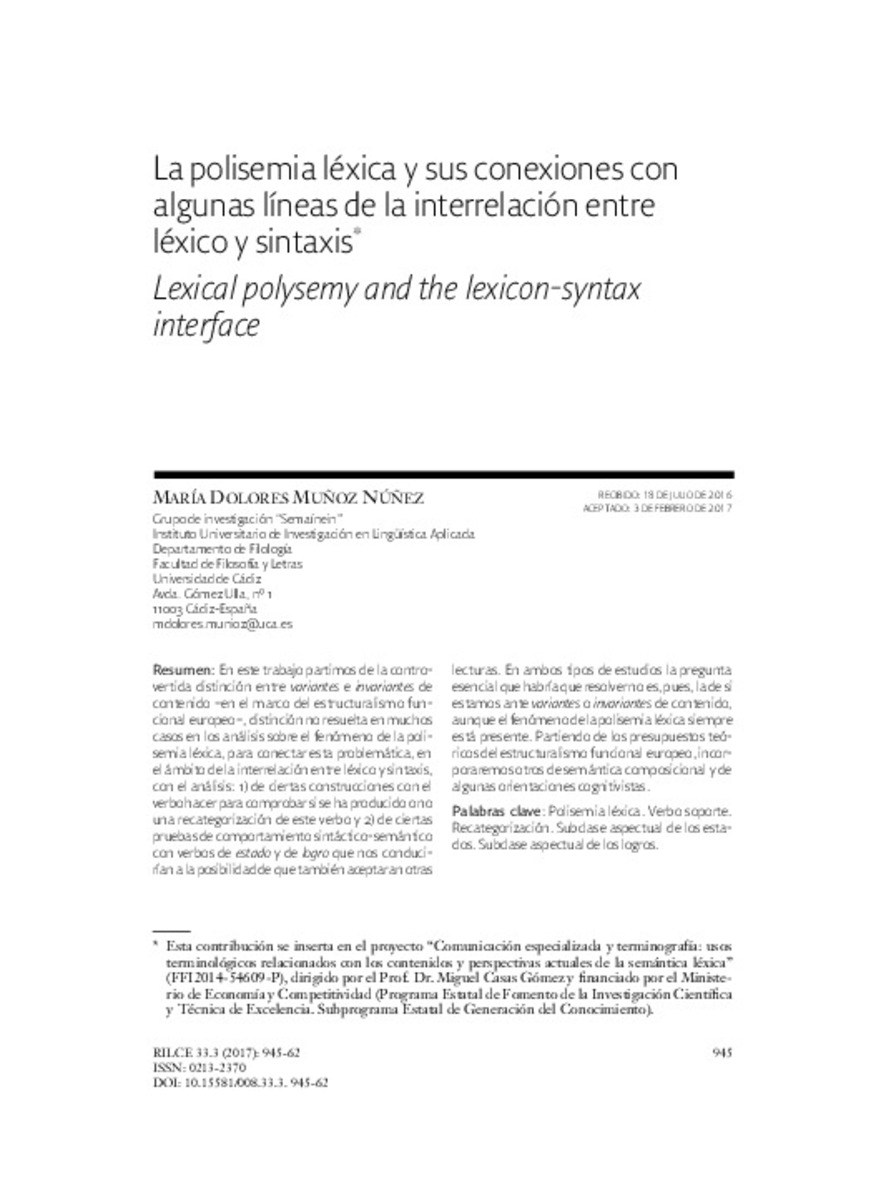Full metadata record
| DC Field | Value | Language |
|---|---|---|
| dc.creator | Muñoz-Núñez, M. D. (María Dolores) | - |
| dc.date.accessioned | 2018-06-11T10:22:28Z | - |
| dc.date.available | 2018-06-11T10:22:28Z | - |
| dc.date.issued | 2017 | - |
| dc.identifier.citation | Muñoz-Núñez, M. D. (María Dolores). "La polisemia léxica y sus conexiones con algunas líneas de la interrelación entre léxico y sintaxis". Rilce. Revista de Filología Hispánica. 33 (3), 2017, 945 - 62 | es |
| dc.identifier.issn | 0213-2370 | - |
| dc.identifier.uri | https://hdl.handle.net/10171/53110 | - |
| dc.description.abstract | En este trabajo partimos de la controvertida distinción entre variantes e invariantes de contenido –en el marco del estructuralismo funcional europeo–, distinción no resuelta en muchos casos en los análisis sobre el fenómeno de la polisemia léxica, para conectar esta problemática, en el ámbito de la interrelación entre léxico y sintaxis, con el análisis: 1) de ciertas construcciones con el verbo hacer para comprobar si se ha producido o no una recategorización de este verbo y 2) de ciertas pruebas de comportamiento sintáctico-semántico con verbos de estado y de logro que nos conducirían a la posibilidad de que también aceptaran otras lecturas. En ambos tipos de estudios la pregunta esencial que habría que resolver no es, pues, la de si estamos ante variantes o invariantes de contenido, aunque el fenómeno de la polisemia léxica siempre está presente. Partiendo de los presupuestos teóricos del estructuralismo funcional europeo, incorporaremos otros de semántica composicional y de algunas orientaciones cognitivistas. | - |
| dc.description.abstract | In this paper we start from the controversial distinction between variants and invariants of content -in the framework of the European functional structuralism-, distinction unresolved in many cases in the analysis of the phenomenon of lexical polysemy, to connect this problem, in the field of the interrelationship between lexicon and syntax, with the analysis: 1) of certain constructions with the verb do to check if it has not produced or re-categorization of this verb and 2) of certain tests syntactic-semantic behavior with verbs of state and achievement that would lead us to the possibility that also accept other readings. In both types of studies the essential question to be solved is not, then, whether we are dealing variants or invariants of content, although the phenomenon of lexical polysemy is always present. Based on the theoretical assumptions of the European functional structuralism, we incorporate other of the compositional semantics and some cognitivists orientations. | - |
| dc.language.iso | spa | - |
| dc.publisher | Servicio de Publicaciones de la Universidad de Navarra | - |
| dc.rights | info:eu-repo/semantics/openAccess | - |
| dc.subject | Polisemia léxica | - |
| dc.subject | Verbo soporte | - |
| dc.subject | Recategorización | - |
| dc.subject | Subclase aspectual de los estados | - |
| dc.subject | Subclase aspectual de los logros | - |
| dc.subject | Lexical polysemy | - |
| dc.subject | Verb support | - |
| dc.subject | Recategorization | - |
| dc.subject | Aspectual subclass of states | - |
| dc.subject | Aspectual subclass of achievement | - |
| dc.title | La polisemia léxica y sus conexiones con algunas líneas de la interrelación entre léxico y sintaxis | - |
| dc.title.alternative | Lexical polysemy and the lexicon-syntax interface | - |
| dc.type | info:eu-repo/semantics/article | - |
| dc.identifier.doi | 10.15581/008.33.3.945-62 | es_ES |
| dadun.citation.endingPage | 62 | - |
| dadun.citation.number | 3 | - |
| dadun.citation.publicationName | Rilce. Revista de Filología Hispánica | - |
| dadun.citation.startingPage | 945 | - |
| dadun.citation.volume | 33 | - |
| dc.date.updated | 2018-06-11T10:22:28Z | - |
| dc.description.version | Peer Reviewed | - |
Files in This Item:
Statistics and impact
Items in Dadun are protected by copyright, with all rights reserved, unless otherwise indicated.






